The Spiritual Path – 12
The Kabbalah, the Tarot and the Middle Way
Kenneth Chan
12. The World of the Limitless
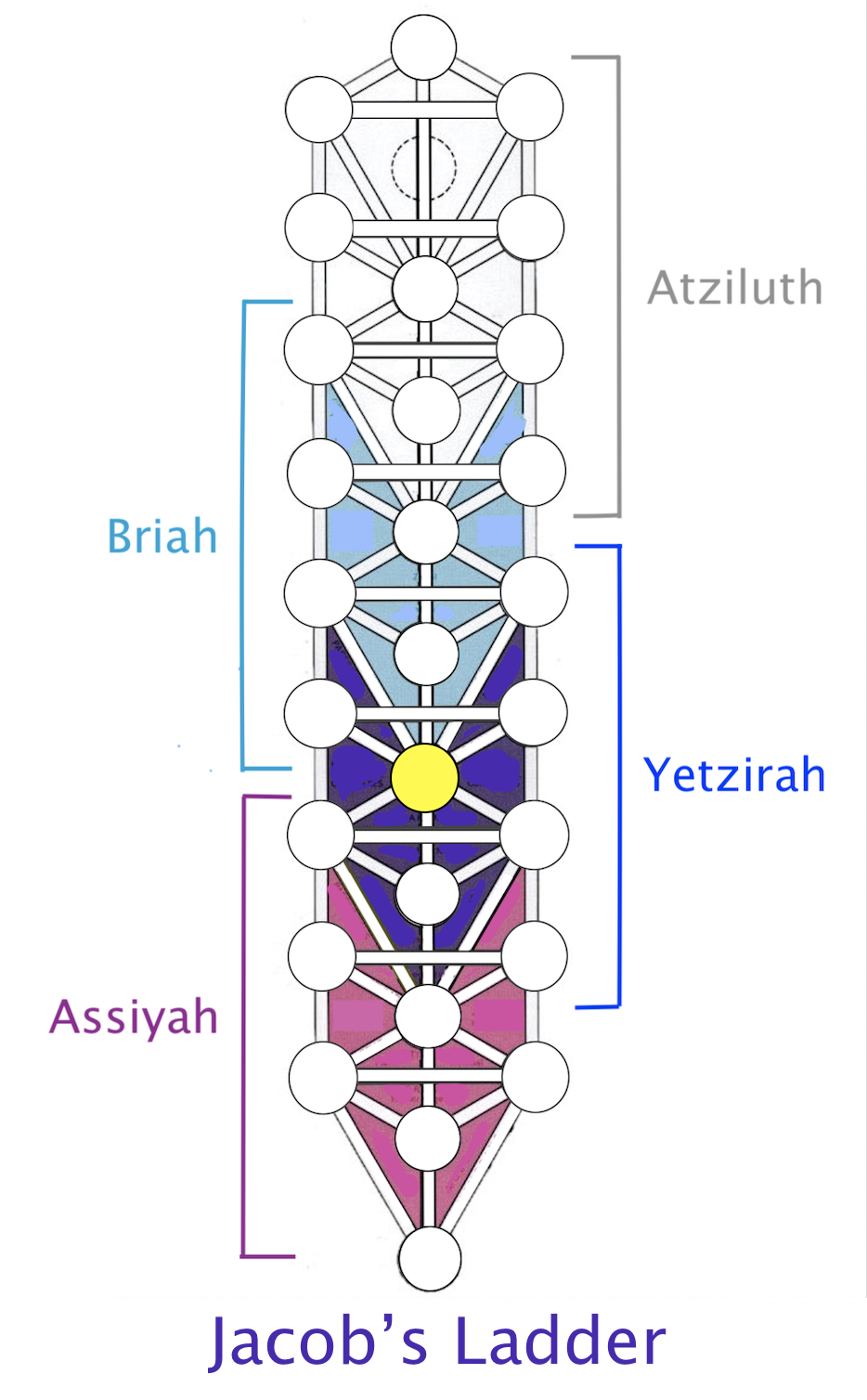
We are entering into the world of the Limitless, the world of Tiphareth in Yetzirah. And Tiphareth here functions in a similar way to Tiphareth in Assiyah. It mediates the process of crossing the next threshold on our spiritual quest, which is the path from Chesed to Geburah. Like the corresponding threshold in Assiyah, this path is one that needs to be traversed many times, each leading to a deepening realization of the union with the Limitless or the All.
There are two paths that lead us to Chesed, and Chesed needs to be primed sufficiently to open this horizontal path that represents the next threshold we need to cross. Chesed again represents our spiritual memory, the source of our conscience, only now, since we are at the level of functioning in relation to the All, it is essentially more akin to what is sometimes called the Akashic Record, the cosmic repository from whence the effects of karma arise.
When we take the path from Netzach to Tiphareth, a path (which we discussed earlier) representing the aligning of our actions to the loss of the sense of self, Netzach also has an effect on Chesed. This effect, caused by our commitment to act in accordance with the realization that the self does not inherently exist, is the path from Netzach to Chesed in the World of Yetzirah, and is represented by the Tarot card, Wheel of Fortune.
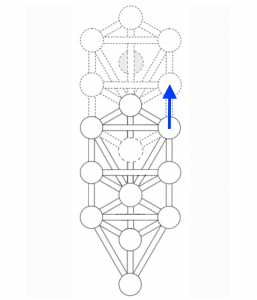
YETZIRAH: Netzach – Chesed
Tarot Card: Wheel of Fortune
Practically all the paths in this World of the Limitless are aimed at developing a deeper and deeper union with the All, since the realization of emptiness and the loss of the sense of self leads also to the loss of separateness from other sentient beings. The path to Chesed thus represents how this affects Chesed, our Akashic Record.
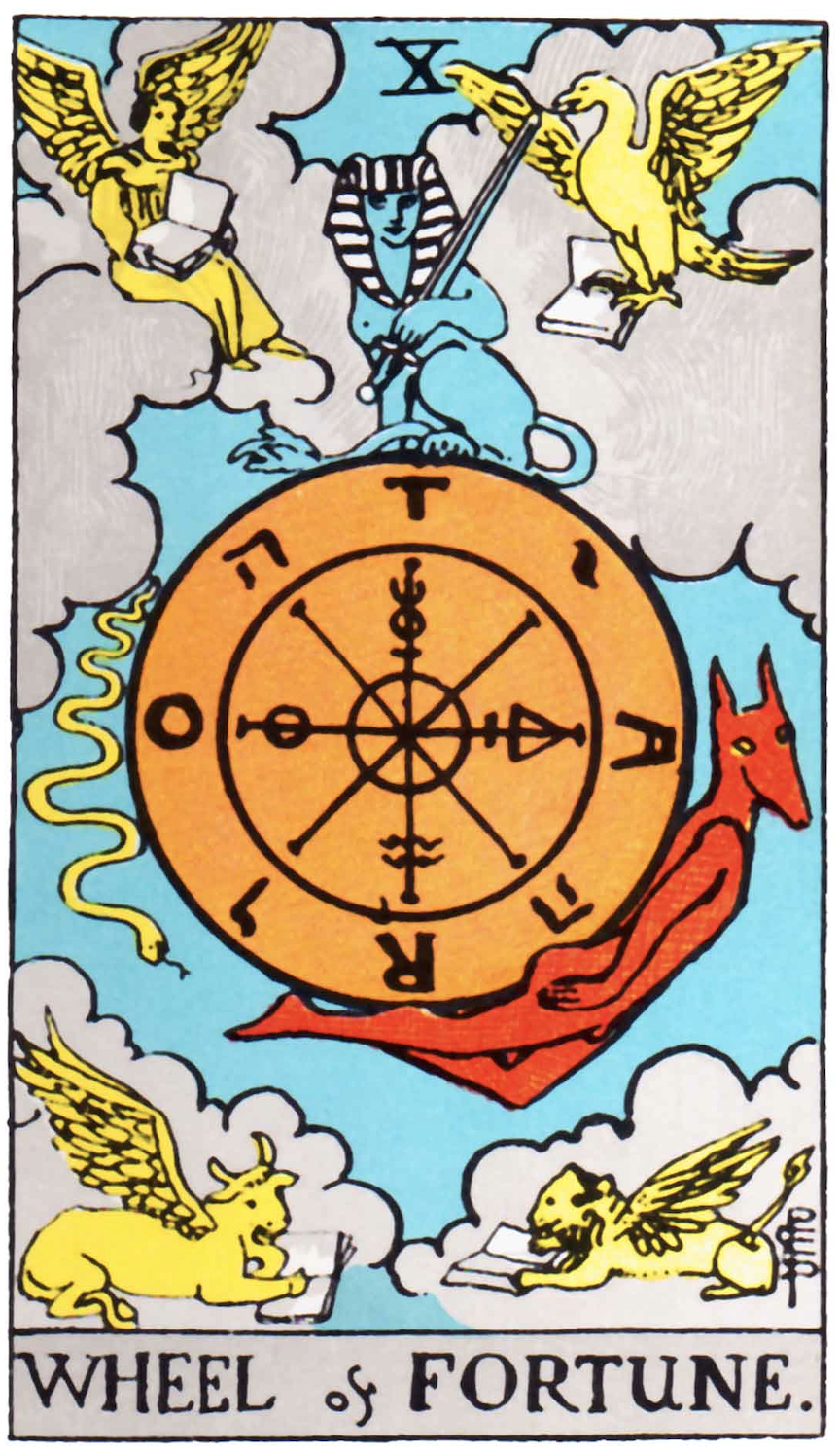
Since it is a process that brings us closer to being at one with the All, it requires the healing of the rifts in the transcendent web that binds us. This is the process of repairing the karmic negativities caused by our past actions that are harmful to others. That is why this path is represented by the Wheel of Fortune, which depicts the Law of Karma. Since the Law of Karma involves all sentient beings, the Four Creatures of Ezekiel—the man, the eagle, the lion, and the ox—are (as in the Tarot card, the World) depicted at the four corners of this Tarot card, and they represent all sentient beings—respectively, humanity, the birds, the wild animals, and the domesticated animals.
This path thus depicts how the aligning of our actions to the loss of the sense of self affects Chesed and leads to a clearing of our negative karma, a healing of the disturbances to the purity of oneness that have been imprinted on the Akashic Record. In other words, before we can proceed higher on the spiritual path, we need to clear our negative karma that is obstructing us from reaching that level. That is why each new realization that brings us closer to the state of oneness and nonseparation is generally accompanied by a ripening of our negative karma. It is a healing process of the links and bonds that binds us in a transcendent state of oneness.
At this stage, the workings of karma thus become increasingly evident for aspirants progressing along the spiritual path. We generally have to heal the rifts caused by our past actions in order to attain to higher and higher spiritual levels. This usually manifests as problems, obstacles, and all manner of suffering, which can appear with uncanny timing. At this stage of the path, they almost regularly accompany significant spiritual progress. It is a process known in Buddhism as purification, and in Christian mysticism as the Dark Night of the Soul. Of course, karma also ripens for those not on the spiritual path when conditions are right; so, there is no escape. The problem then is that, tragically, when bad karma ripens (while we are not on the path), there is no accompanying spiritual attainment.
The path from Netzach to Chesed leads us to the threshold between Chesed and Geburah, a path represented by the Tarot card, Justice:
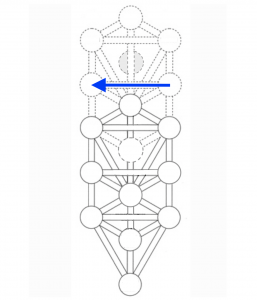
YETZIRAH: Chesed – Geburah
Tarot card: Justice
It is probably appropriate here to discuss why the Tarot cards used for delineating the paths on the Tree of Life are from the Waite-Smith deck (also known as the Rider-Waite or Rider-Waite-Smith deck, Rider being the company that published the cards). The actual artist of the pictures was Pamela Colman Smith, and she was guided in the creation of the Tarot cards by Arthur Waite who was a practicing scholar of mysticism. Both were members of the Golden Dawn. Although Arthur Waite was definitely more knowledgeable about mysticism, it may have been Pamela Colman Smith that was the more important of the two in the production of the cards. This was because Pamela Colman Smith was clairvoyant. In all likelihood, she knew what the cards should look like even though she may not have necessarily understood why. It was exactly this visionary quality in Pamela Colman Smith that made Arthur Waite choose her as the artist for this project of producing the Tarot card pictures.
One significant thing we need to note here about the Waite-Smith deck is that Arthur Waite switched the numbering of the Justice and Strength cards. Waite wrote, in his commentary on the Tarot card, Strength: “For reasons which satisfy myself, this card has been interchanged with that of Justice, which is usually numbered eight. As the variation carries nothing with it which will signify to the reader, there is no cause for explanation.” Unfortunately, this switch made by Arthur Waite, and one which has since been followed by most Tarot card decks created after that, does alter the placement of the cards with respect to the paths on the Kabbalah Tree of Life. For that reason, the switch should not have been made. We need to revert back to the original numbering of the cards in order to get the correct representation of the paths on the Tree of Life. This means that Justice should really be numbered eight and Strength should be numbered eleven, both of which are the correct and original numbers assigned to the cards. Thus, it is the Tarot card, Justice, that correctly depicts the path from Chesed to Geburah.
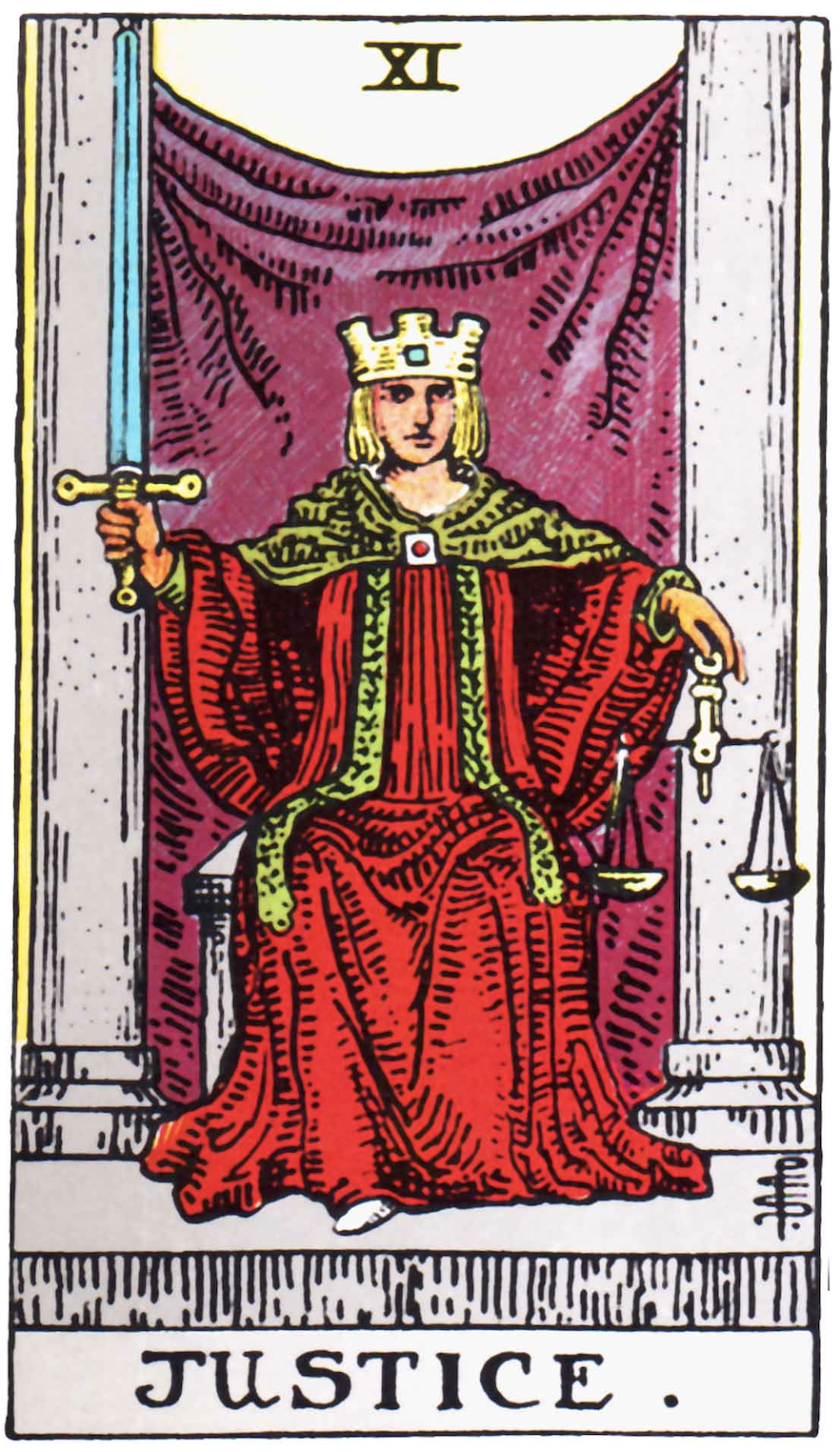
The Tarot card, Justice, shows a lady holding, in her left hand, a scale balance, and in her right hand, a double-edged sword. Both of these represent the law of karma, for we reap what we sow. The scales depict the fact that all the effects we create onto others are balanced out by the effects that rebound back on us. And the sword is the double-edged sword that cuts both ways, depicting the fact that what we do to others will equally return to affect us. The lady in the Justice card is also seated between two pillars, signifying that this path is a means to bring about the state of nonduality. Significantly, she is not blind-folded, correctly informing us that, here, it is a path of gaining a deeper realization of how to transform ourselves into a closer union with the All.
This path, between Chesed and Geburah, thus represents both the realization of how to attain a deeper unitive state, as well as a healing of the karmic rifts that would enable us to actually transform into this higher spiritual state of union with the All. Our commitment to taking this path is the threshold we have to cross in order to progress on our spiritual quest. This path is also the third of the four obscurations to Buddhahood given by the Uttaratantra Shastra. Recall that the passage from this scripture reads:
Enmity towards the Dharma,
A view asserting an existing self,
Fear of samsara’s suffering,
And neglect of the welfare of fellow beings
Are the four veils …
This “fear of samsara’s sufferings” is the obstacle that we need to overcome here in order to progress further on our spiritual quest. We need to persevere in spite of the fact that we repeatedly encounter obstacles and the ripening of our bad karma practically every time we take this path between Chesed and Geburah. This path thus represents both the gaining of a new realization that brings us into a closer union with the All, as well as a ripening of our negative karma, which is a healing process that will allow us to actually make the transformation towards a greater union with the All.
This is a well-known phenomenon in Tibetan Buddhism, and it is said that “where there is dharma, there are obstacles.” The ripening of our negative karma may take many different forms. Sometimes we just fall sick, sometimes it is in the form of circumstances that cause us psychological pain, and sometimes it may be just the unfolding of disturbances that cause us to lose the intensity of our new realization to the point where we may actually have to do it all again. What we can be reassured about is that these obstacles will never be so severe as to force us to stop our progress on the spiritual path. We can be assured that we will always be able to proceed if we have the will to persevere and to forge ahead in spite of the obstacles.
It is also said, in Tibetan Buddhism, that although these processes of clearing our negative karma do get triggered by striving forward in our spiritual quest, they come with a “discount.” In other words, the degree of suffering from our negative karma brought about by this spiritual progress is a lot less than what would occur under the usual circumstances of karmic ripening caused by other conditions. We may, for example, just suffer a headache when, under the usual mundane conditions, the same negative karma may have caused us the equivalent of a long time in the hell realms. Why we get a “discount” may be seen in another way. An interference to our functioning at a higher spiritual state clears a lot more negative karma compared to an interference to our functioning at a mundane level. In other words, the obstruction to a higher spiritual state of mind clears much more negative karma than the obstruction to a mundane state of mind, simply because the phenomenon of obstructing a higher spiritual state is a greater negative effect compared to that of obstructing a mundane state. So more negative karma is cleared when karmic ripening is brought about by striving on the spiritual quest.
It may seem ironical but this regular recurring process of the ripening of negative karma is actually one way of verifying that the spiritual path is real. We also learn that karma is real because of the almost clockwork precision by which we can trigger it off every time we gain a new realization. There are other ways to purify our negative karma, but these may have to be performed perfectly if we are to escape the ripening of our negative karma completely. Thus, complete purification may not always be possible unless we are already an advanced spiritual being. The intensity of the karmic ripening may, however, be reduced by such practices.
The threshold between Chesed and Geburah has to be traversed many times, and the reason is this. While one statement like “a union with the All” covers the realization of the unitive experience, there are actually many levels of this realization which would be described by the same words. This becomes clearly evident when we actually strive to transform ourselves in this way. Our perspective and psyche cannot be transformed all at once into something completely different. This generally needs to be done in stages, and the difference in the stages would be difficult to distinguish in terms of words, since they would all fall under the category of “establishing a closer union with the All,” simply because of the limitation of language. Yet each stage is definitely different, and after one successful change in our psyche, there will appear the realization that yet another aspect of our psyche or way of thinking needs to be transformed. The difference in these stages can hardly be differentiated in words, but the aspirant will know that it is another level of transformation. That is why this path from Chesed to Geburah has to be traversed many times, and each time the path is taken, it will bring us closer to the ideal state of what is still—because of the limitations of language—similarly described as “a closer union with the All.”
In summary, each stage of this transformation in establishing a closer union with the All generally triggers off a ripening of our negative karma. That is why the Tarot card assigned to this path is that of Justice. The Uttaratantra Shastra also describes the remedies for all the four obstacles it delineates (in the correct sequence) on Jacob’s Ladder, and the remedy for this “fear of samsara’s suffering” brings us to the path between Tiphareth and Chesed, a path represented by the Tarot card, The Hermit:
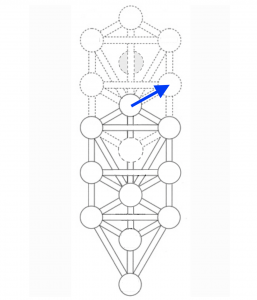
YETZIRAH: Tiphareth – Chesed
Tarot Card: The Hermit
Noble Eightfold Path: Right Speech

The Tarot card depicting this path shows a hermit, in a meditative state, standing on a mountaintop, and carrying a lamp, a lamp that means to provide illumination for everyone. It thus represents the meditative aspiration to help all beings by showing the way. The lamp also mainly throws light upon himself and thus signifies that he is also seeking from within himself the solution, the means to reach enlightenment so that he can then help to light the way for others to also take the spiritual path and escape the sufferings of samsara.
This is the path designated by the Noble Eightfold Path as that of Right Speech. Again, this is taken to refer to the winds in our psychic channels, the source of our speech. It is thus the right movement of the winds through an aspiration felt with a deep yearning to relieve the distress of others. It is a yearning that seeks to bring forth the mystic flame within everyone that will illuminate the path without leaving anyone in the dark. It seeks thus a brotherly embrace of transcendence that will illuminate all within a glow of unity.
This aspiration, coming from an abiding depth of feeling for the distress of others, is thus the path of Right Speech coming from Tiphareth, a path that will stir the cosmic memory in Chesed to reveal yet another realization that increases the depth of oneness with the All. It enables us to again take the path from Chesed to Geburah, now at a higher level of realization, and thus cross another threshold to help us progress further in our spiritual quest. This then is the remedy for the “fear of samsara’s suffering” which is the third of the four veils of obscurations to Buddhahood. The remedy is described in the third line of this passage from the Uttaratantra Shastra:
Those whose seed is devotion towards the supreme vehicle,
Whose mother is analytical wisdom generating the Buddha qualities,
Whose abode is the blissful womb of meditative stability,
And whose nurse is compassion,
Are heirs born to succeed the Muni.
The “blissful womb of meditative stability” may be taken to refer to the state of samadhi (meditative stability) which itself is a state of bliss and hence can provide a protective womb against the sufferings of samsara.
However, this third line of the passage from the Uttaratantra Shastra also refers to a remedy in another sense. The very deeply felt commitment and yearning to relieve the suffering of others, through a total giving of oneself, will itself generate a sense of profound bliss. The nature of this bliss occurs on a different plane from that of the mundane suffering of samsara, and in fact, can be experienced at the same time as the suffering of samsara. It is of a deeper and more profound nature, and hence can make the mundane suffering much less important. The nature of this profound bliss can be discerned from the following passages from Candrakirti’s Madhyamakavatara (Guide to the Middle Way):
Those who hold in their mind a promise to help living beings
Immediately experience joy from giving.
Therefore whether one is compassionate or not,
The instructions on giving are fundamental.
If hearing and contemplating the word “Give,”
The Conquerors’ Son develops a bliss
The like of which is not aroused even in the sages entering nirvana’s peace,
What can be said about giving everything?
Through the pain from cutting and giving his body,
He sees from his own experience
The suffering of others in the hells and elsewhere,
And strives with great effort to eliminate it quickly.
Although Candrakirti is describing the profound bliss of a Bodhisattva, a very advanced being, the passage does indicate the nature of the bliss that comes from the deep commitment to relieve the sufferings of others through a total giving of oneself. It is bliss of a profound nature that will more than compensate for the mundane suffering of samsara. This then is the remedy for the third veil of obscuration delineated in the Uttaratantra Shastra.
With this deep aspiration to save all sentient beings, represented by this path from Tiphareth to Chesed, a new realization, together with a healing of a prior breach in the transcendence that binds us, will issue forth from Chesed, and enable us to again take the horizontal path from Chesed to Geburah. In other words, we will have to cross the threshold again at a new level, a process that involves gaining a new realization to bring us to a closer union with the All, together with a ripening of karma that will enable us to enter into a more profound state of unity. The stage is then set for a further refinement of the realizational state of Tiphareth via the path from Geburah, the Sephirah that represents the depths of our inner will, that will propel us onward spiritually.
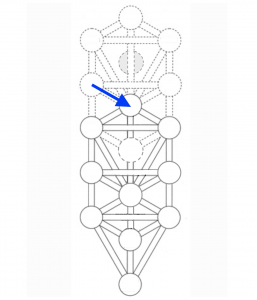
YETZIRAH: Geburah – Tiphareth
Tarot Card: Strength
Noble Eightfold Path: Right Mindfulness
Recall that the numbering of the Strength and Justice cards were unfortunately switched by Arthur Waite, without realizing that it is the original numbering that gives the correct placement of the Tarot cards on the Tree of Life. Hence the Tarot card, Strength, should really be numbered eleven, and it depicts this path from Geburah to Tiphareth.
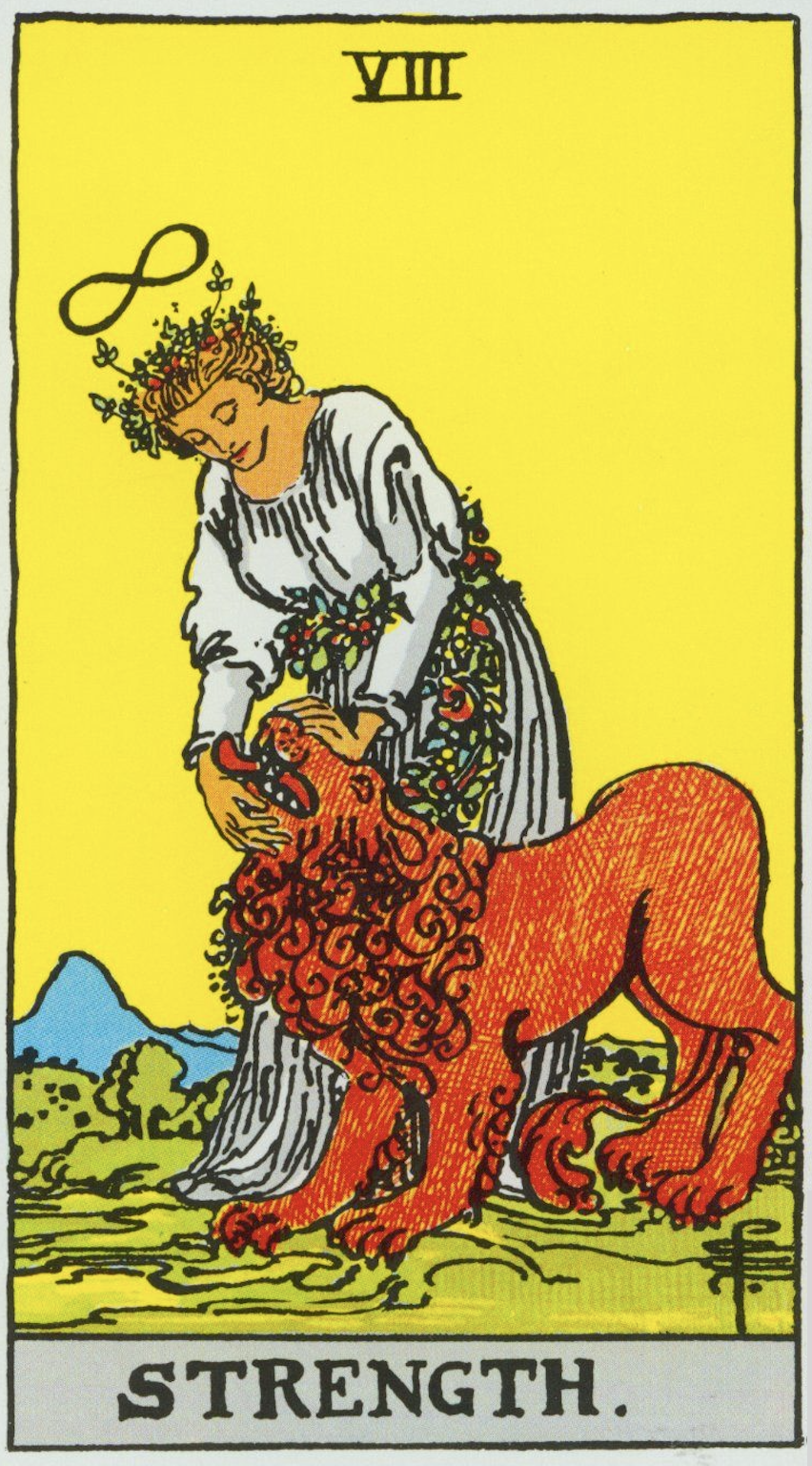
This path is designated by the Noble Eightfold Path as that of Right Mindfulness. It is thus the process of maintaining the mindfulness of the new realization received on the horizontal path from Chesed to Geburah, so that it will transform our realizational state of mind in Tiphareth to a higher level.
The Tarot card shows a lady, with a halo, gently closing the mouth of a lion, without the use of physical force, because the lion is essentially already subdued. Strength is thus depicted in her ability to do that. What this represents is that the realizations that result in a more profound union with the All subdue the forces of karma. If we gain the purity of oneness, and are not separate from the All, we would naturally cease to harm others because there are really no “others” to harm, since we are all one. All tendencies to create negative karma would naturally subside, and this is the real strength. The halo on the lady tells us that this is a divine force, and not a physical one.
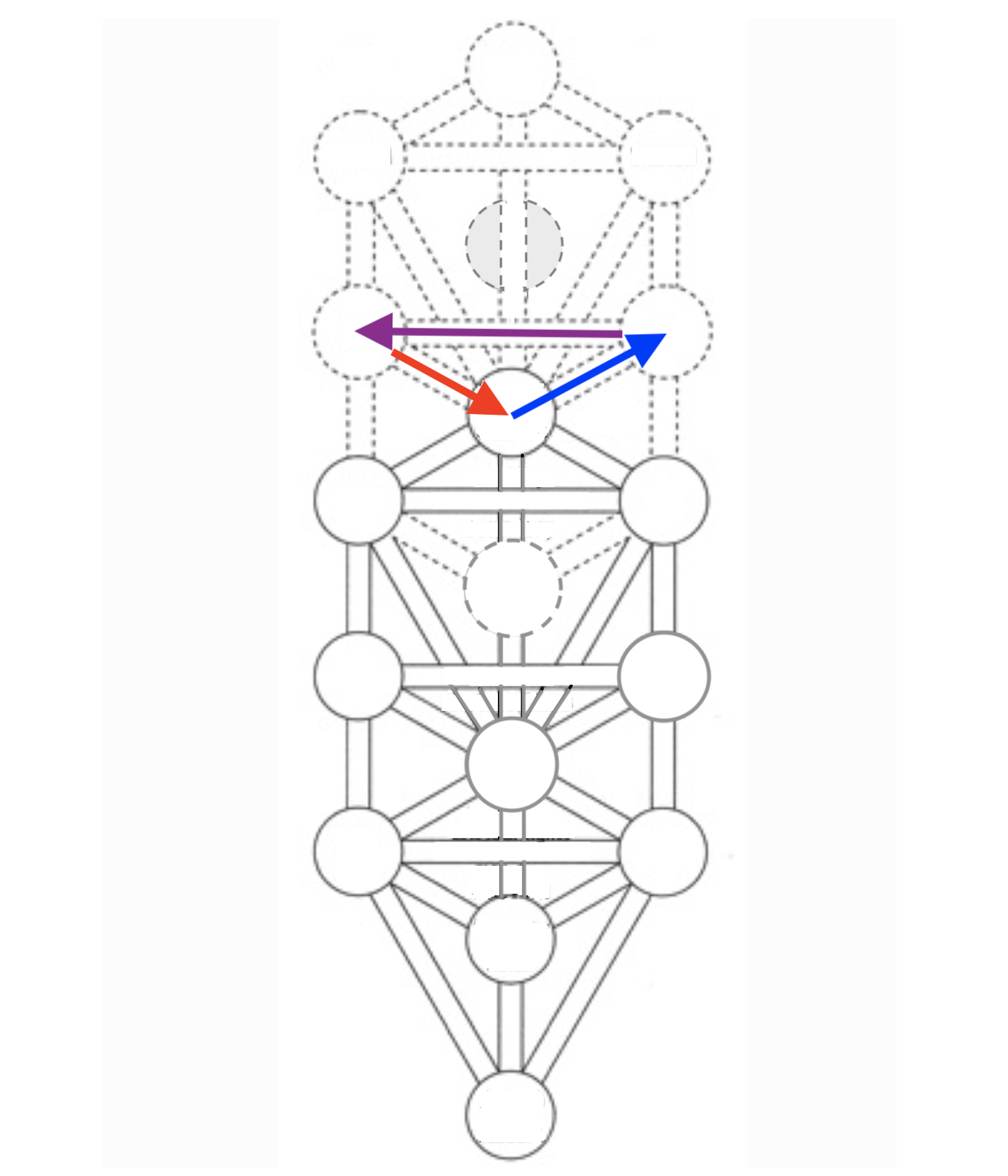
By maintaining the Right Mindfulness of the new realization we have gained from the path linking Chesed to Geburah, and undergoing a phase of healing through the ripening of our negative karma, we further transform our realizational state of mind in Tiphareth and bring us to a closer state of union with the All. This completes the circuit that runs from Tiphareth to Chesed, and then to Geburah, and back again to Tiphareth. It functions here in the World of Yetzirah in a way that parallels that found in the World of Assiyah. And like the corresponding circuit in Assiyah, this circuit in Yetzirah has to be traversed many times. It is the powerhouse that will repeatedly bring us closer to a unitive state of oneness with the All, and this will eventually enable us to travel higher on Jacob’s Ladder.
Copyright © 2021 by Kenneth K C Chan. All Rights Reserved.